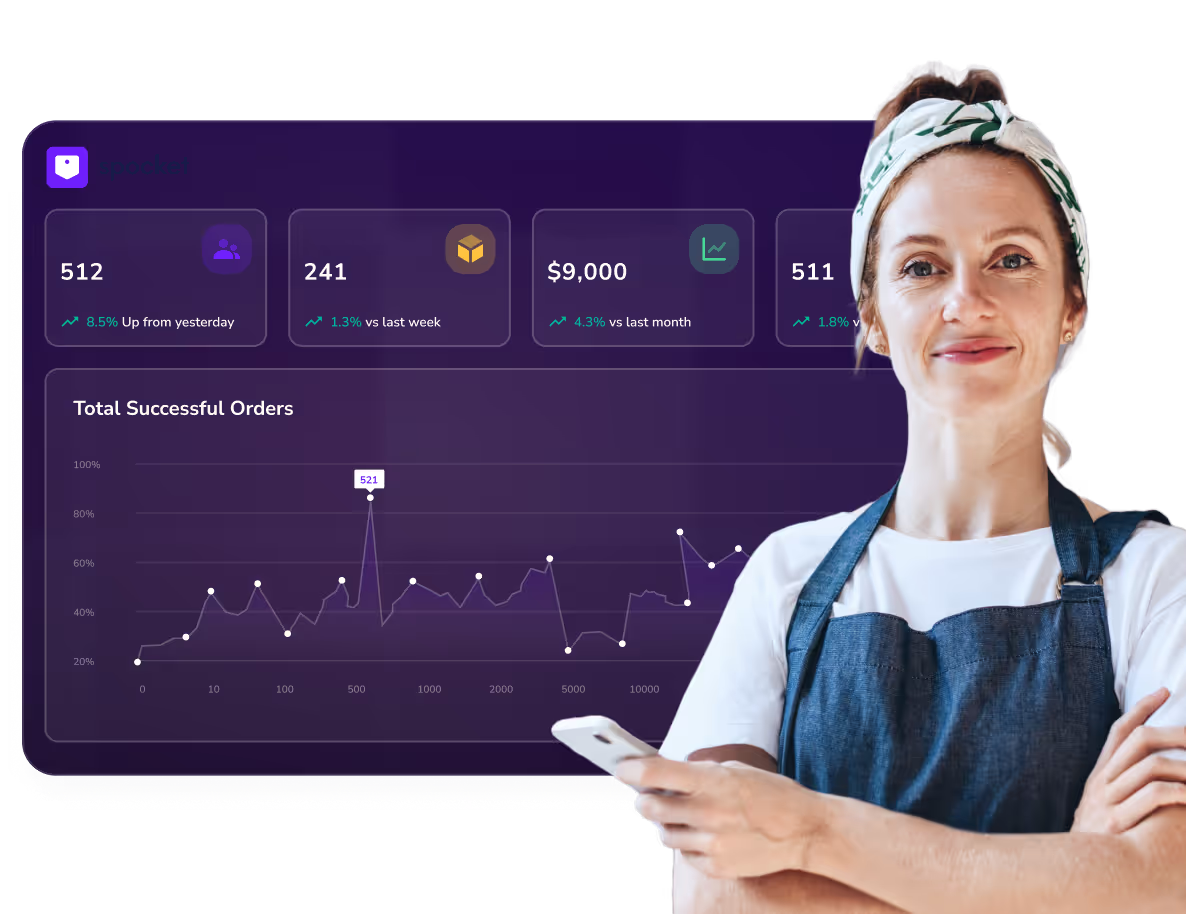Manufacturers must adapt to a rapidly evolving market, where efficiency and digitalization drive growth. The global B2B e-commerce market, valued at $19.8 trillion (2023), is projected to hit $82.5 trillion by 2032, growing at 17.24% CAGR.
Industry leaders like Apple ($500B AI-focused investment) and ABB (expanding U.S. production) prioritize B2B strategies to streamline operations and boost competitiveness. Investments in AI, automation, and direct business partnerships are reshaping manufacturing, reducing costs, and expanding market reach.
With technology-driven solutions fueling industrial growth, manufacturers embracing B2B models gain a competitive edge and ensure long-term success.
What is B2B Manufacturing
Business-to-Business (B2B) manufacturing refers to producing goods sold to other businesses rather than directly to consumers. This model plays a crucial role in the global supply chain, where manufacturers create products, components, or raw materials used in further production or distribution.
Unlike Business-to-Consumer (B2C) manufacturing, where companies sell finished products directly to customers, B2B manufacturing typically involves bulk orders, long-term contracts, and specialized production processes.
Key Features of B2B Manufacturing
- Complex Sales Cycles: B2B transactions involve multiple decision-makers, long negotiation periods, and custom pricing.
- Supply Chain Dependence: Manufacturers rely on stable relationships with suppliers and logistics partners.
- Customization & Compliance: Products often need to meet industry regulations, technical specifications, and customization requests.
- Technological Advancements: The sector is increasingly adopting AI, IoT, and automation for enhanced productivity and efficiency.
B2B Manufacturing Market Trends & Growth in 2025
1. Global Market Size & Projections
The B2B eCommerce market which includes industrial and manufacturing transactions is estimated at $36.11 trillion in 2031, having a CAGR of 19.2% from 2023 to 2031.
2. Digital Transformation & AI Adoption
- Over 75% of B2B manufacturers are integrating AI-powered automation for improved operational efficiency.
- Predictive maintenance using IoT is reducing equipment downtime by 30%, saving billions in lost productivity.
- Cloud-based manufacturing solutions are expected to double in adoption by 2026.
3. U.S. Manufacturing Industry Outlook
- The National Association of Manufacturers (NAM) forecasts a 1%-4% growth in the manufacturing sector for 2025.
- Inflation rates for industrial production are expected to stabilize at 2%-3%, while material costs are projected to rise by 1.7%-2.6%.
- The U.S. manufacturing workforce is projected to exceed 10.48 million jobs by the end of 2025.
4. European & Global Manufacturing Landscape
- Germany: Pessimism prevails among German firms, with 60% predicting economic downturns.
- Eurozone: Factory activity shows signs of stabilization, with PMI indicators suggesting gradual recovery.
- China: Industrial production is forecasted to grow by 5.1%, driven by government-led initiatives in green manufacturing.
The Future of B2B Manufacturing
With the rise of Industry 4.0, supply chain digitalization, and AI-driven production, the B2B manufacturing sector is set for a transformation. Companies that adopt smart manufacturing, automation, and sustainable practices will gain a competitive edge in 2025 and beyond.
Key Takeaways
- AI & IoT are reshaping B2B manufacturing with predictive analytics and automation.
- Manufacturing eCommerce is a trillion-dollar market, growing exponentially.
- Inflation, supply chain stability, and workforce shifts will be key challenges.
- Sustainable manufacturing is becoming a global priority.
What are B2B Manufacturing Sales Channels
B2B manufacturing sales channels refer to the different methods manufacturers use to sell their products to businesses. Unlike B2C (Business-to-Consumer) sales, which focus on individual customers, B2B sales involve bulk orders, long-term contracts, and specialized supply chain strategies.
Understanding these sales channels is essential for manufacturers looking to optimize their distribution, expand market reach, and increase revenue.
Below are the primary B2B manufacturing sales channels and how they function.
Direct Sales (Manufacturer to B2B Customers)
Direct sales occur when a manufacturer sells its products directly to businesses without intermediaries like wholesalers or distributors. This model allows greater control over pricing, branding, and customer relationships.
Key Features of Direct Sales
- Higher Profit Margins: No middlemen mean more revenue per sale.
- Better Customer Relationships: Direct communication fosters trust and loyalty.
- Customization Opportunities: Manufacturers can tailor products to meet client needs.
Challenges
- Higher Sales & Marketing Costs: Requires an internal sales team and digital presence.
- Logistics & Fulfillment Responsibility: Manufacturers must handle warehousing, shipping, and customer service.
Best For
- Industrial equipment manufacturers
- OEM (Original Equipment Manufacturer) suppliers
- Technology and machinery providers
For example, in metal fabrication, manufacturers often invest in a plasma cutter as it offers precise, fast, and consistent results. These integrate seamlessly into production lines, boosting efficiency while maintaining high-quality standards. It allows businesses to offer customized solutions efficiently, meeting client specifications while maintaining production speed. This highlights how investing in specialized equipment can enhance the value proposition in B2B transactions.
Distributor or Partner Sales
In distributor or partner sales, manufacturers sell bulk products to distributors who then supply them to businesses, wholesalers, or retailers. This model enables wider market coverage and faster product distribution.
Key Features of Distributor Sales
- Market Expansion: Distributors help reach more customers, including overseas markets.
- Reduced Operational Costs: Manufacturers don’t need to manage individual business accounts.
- Scalability: Easier to enter new industries or territories.
Challenges
- Lower Profit Margins: Distributors take a percentage of sales.
- Less Control Over Branding & Pricing: Distributors may sell at different prices, affecting market perception.
Best For
- Chemical and raw material suppliers
- Automotive parts manufacturers
- Medical equipment providers
B2B Ecommerce Platform Manufacturing Distribution Model
The B2B eCommerce model involves selling manufacturing products via online platforms, digital marketplaces, or manufacturer-owned websites. This approach is becoming increasingly popular with Industry 4.0 and digital transformation.
Key Features of B2B eCommerce Sales
- Automation & Efficiency: Online platforms streamline ordering and payments.
- Data-Driven Sales: Analytics help manufacturers optimize inventory and pricing.
- Global Reach: Allows international businesses to place bulk orders seamlessly.
Challenges
- High Initial Investment: Requires robust digital infrastructure.
- Competition: Marketplaces can be saturated with competitors.
Best For
- Wholesale manufacturers
- Electronics & hardware providers
- Industrial tool suppliers
Popular B2B eCommerce Platforms
- Alibaba (Global B2B marketplace)
- Amazon Business (E-commerce for businesses)
- ThomasNet (Industrial manufacturing marketplace)
Private Labeling
Private labeling is when manufacturers produce goods that another company sells under its brand name. This sales channel is common in the food, cosmetics, and consumer goods industries.
Key Features of Private Labeling
- Consistent Revenue Stream: Businesses sign long-term supply agreements.
- Minimal Branding & Marketing Costs: The retailer handles customer-facing branding.
- High Production Demand: Private label clients often place large-volume orders.
Challenges
- Limited Brand Recognition: The manufacturer's name is usually hidden.
- Dependent on Third-Party Sellers: Success depends on how well the retailer markets the product.
Best For
- Clothing & apparel manufacturers
- Cosmetic & skincare producers
- Nutritional supplement companies
Benefits Of B2B eCommerce For Manufacturers
Investing in B2B eCommerce offers manufacturers numerous advantages, especially as the digital landscape evolves in 2025:
- Revenue Growth: Approximately 39% of manufacturers have reported increased revenue after implementing eCommerce solutions.
- Expanded Market Reach: The global B2B eCommerce market is projected to reach $82.5 trillion by 2032, providing manufacturers with access to a vast and growing customer base.
- Enhanced Customer Experience: By 2025, 80% of B2B transactions are expected to occur online, highlighting the need for manufacturers to offer seamless digital purchasing options.
- Operational Efficiency: Integrating eCommerce platforms with existing ERP and CRM systems streamlines order processing and inventory management, reducing errors and operational costs.
- Data-Driven Decision-Making: Access to first-party customer data enables manufacturers to identify purchasing trends and tailor offerings, leading to improved customer satisfaction and retention.
- Competitive Advantage: Embracing eCommerce allows manufacturers to stay ahead of competitors by meeting the increasing demand for digital purchasing options and personalized experiences.
Conclusion
The shift toward B2B strategies is no longer optional—it’s essential for manufacturers aiming for long-term growth and competitiveness. With the global B2B eCommerce market projected to reach $82.5 trillion by 2032, manufacturers investing in digital transformation, automation, and AI-driven sales channels stand to gain significant advantages.
From higher revenue and operational efficiency to expanded market reach and stronger business relationships, B2B investments are fueling industry success. Companies like Apple and ABB are already capitalizing on these opportunities, setting a benchmark for modern manufacturing.
By embracing B2B models, leveraging technology, and optimizing supply chain strategies, manufacturers can future-proof their businesses, reduce costs, and drive sustainable growth in an evolving digital economy. The time to invest in B2B is now.







































